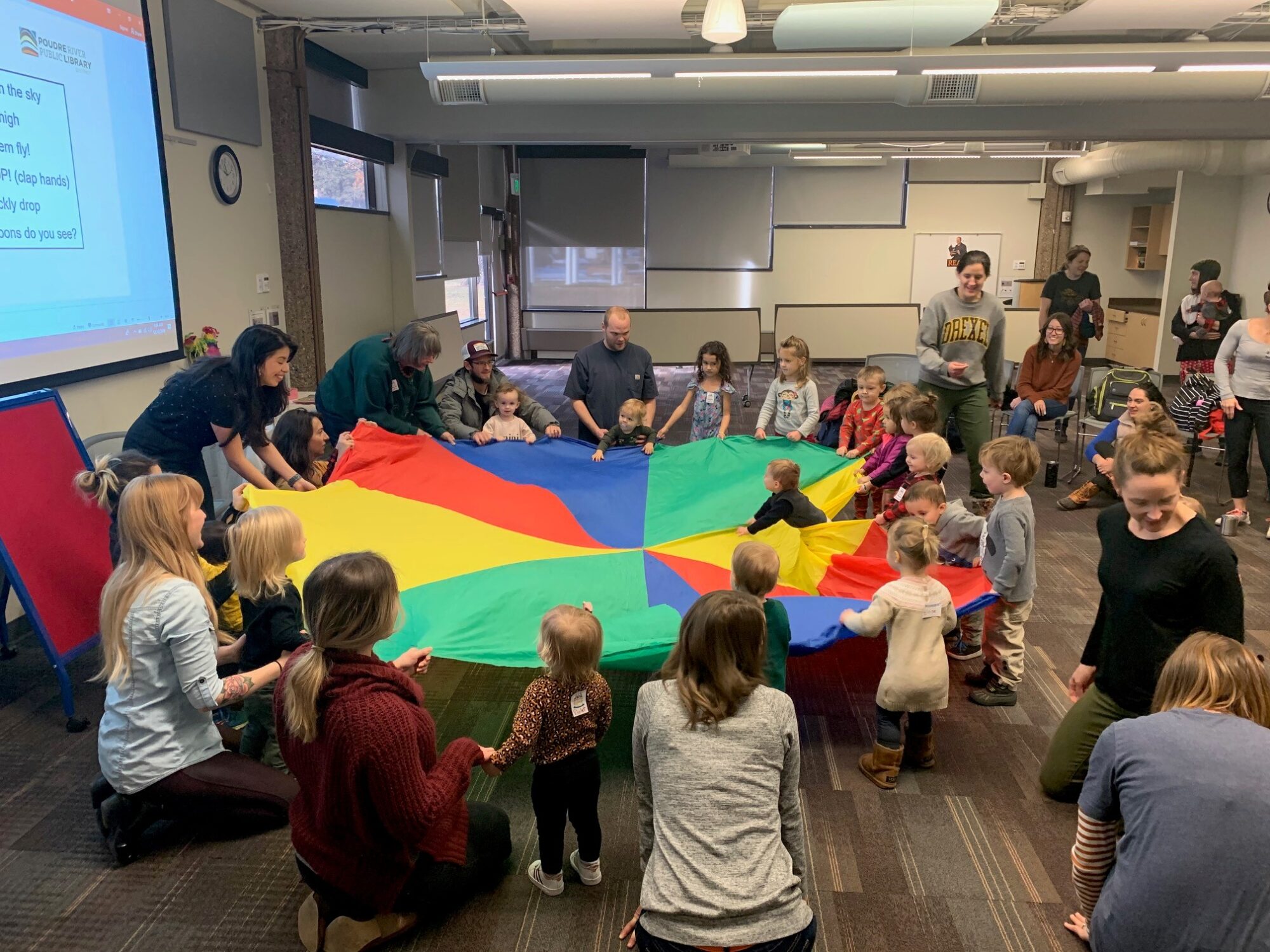Every Thursday morning, young kids and adults visit Old Town Library for Bilingual Storytime / Hora de Cuentos Bilingüe. This dual-language storytime debuted in 2018 and has quickly become a favorite for many local families. In fact, the program had to move from the Storytime Room to the larger community meeting room to accommodate all of the participants.
On one particular Thursday, Eloise (who is probably 3 or 4 years old) is happily waiting for her storytime friends to arrive and pointing out each “niño” and “niña” as they come through the door. Young Jay has recently learned to walk and is making use of his new found skills. Little Caroline is crawling around enjoying all the activity around her.

When it’s time to get started, storytime leader Monique sits on a chair in the front of the room with a pink ukulele in hand, ready to welcome the group of nearly 50 people, mostly children (from babies to kindergarten aged) along with their parents and caregivers. The day’s theme is Feliz Cumpleaños to celebrate Rafael the raccoon puppet’s birthday.

At the Library’s many bilingual and world language storytimes, you’ll find a mixed group of dual language learners: Young children learning two or more languages at the same time (for example, Spanish and English) and those children learning a second language while continuing to develop their first (or home or heritage) language.
Additionally, you’ll find parents and caregivers who are learning right alongside their child.
“We attend storytimes at all of the libraries,” says a dad of a young toddler, “and always make sure to come to Bilingual Storytime. It’s a lot of fun and the bilingual stories and songs offer great variation. Plus, Monique is amazing.”

The early years are an ideal time to expose babies, toddlers, and young children to bilingual books and programs. Children are particularly open to learning multiple languages at the same time. In fact, babies are born “wired for language” and can discriminate among all the sounds of every language and learn them.
Even if you are not bilingual, you can still raise a bilingual child by exposing your child to different languages through books, music, and storytimes.
Benefits of Bilingualism
It’s actually a common misconception that learning another language at a young age will confuse or hinder a child’s literacy development.
Research shows bilingual brains have an edge. Speaking two languages actually benefits children’s overall learning, marked by larger vocabularies and better executive brain function.
Cognitive and Social Benefits of Bilingualism
- Higher-level cognitive abilities
- Flexible problem solving skills
- Improved focus, memory, and decision making
- Strong use of logic and abstract thinking
- Improved self-control / self-regulation
- Boosted brain plasticity
- Protection against cognitive decline and dementia
- Maintain and strengthen ties to culture, community, and personal identity
- Increased comfort with diversity and different cultures
- More meaningful participation in the global community
- Increased job opportunities

Bilingual and World Language Storytimes at the Library
All of the Library’s professional storytimes follow Every Child Ready to Read literacy practices with fun, educational activities for reading, talking, singing, playing, and writing. Plus, they offer support for families and caregivers to re-create storytimes at home.
The Bilingual Storytimes and World Language Storytimes also feature cultural practices that enrich the overall storytime experience.

Leah Weatherman, a library assistant with the Community Services (Outreach) team frequently visits rural and mountain schools for English and Spanish storytimes that include cultural songs and stories, present traditional holidays and celebrations, and highlight other cultural connections like Mexican folkart.
“Not only are we honoring people’s cultures and identities, but we’re helping young children develop cultural awareness by including different cultural elements in storytimes,” Leah explains. “Plus, we’re showing that it’s okay to speak to different languages by normalizing Spanish and English at school and in the community.”
At the Feliz Cumpleaños-themed storytime, Monique brought out a piñata and talked to the children about how piñatas are used at birthday celebrations. The children then pinned colored ribbons onto a felt board piñata as they learned different colors in English and Spanish.

If you’re interested in participating in bilingual storytimes or family programs at the Library, visit our online events calendar for a schedule of upcoming programs including
- Bilingual Storytime / Hora de Cuentos Bilingüe
- World Language Storytime
- Noches en Familia
- Story Express (summer only)
Thank you to Library District staff Monique Ramos, Ludy Rueda, and Leah Weatherman for contributing to this blog post.

